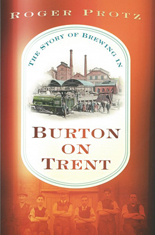
History Press, softcover, £ 12.99, 153 pages
Admirers of British beer know that Burton on Trent is one of England’s great brewing towns. Its breweries—Ind Coope, Bass, Worthington’s, Allsopp—developed India Pale Ale, Britain’s leading export beer in the 19th century. Burton breweries also developed Burton Ale, an ancestor of today’s barley wines.
In The Story of Brewing in Burton on Trent, Roger Protz has produced the first book solely devoted to the history of brewing in Burton. Protz tells Burton’s story with his usual flair and panache.
Brewing in Burton dates back to the Middle Ages, when the Burton Abbey had a substantial brewery to satisfy thirsty pilgrims. But it wasn’t until the 18th century that Burton began to become a brewing powerhouse. Protz offers two reasons why Burton brewers grew substantially. The breweries draw their water from nearby wells with soft water that has high levels of calcium and magnesium salts, ideal for brewing. An additional innovation came from 19th-century inventor Peter Walker, who developed “unions,” consecutive square trays that helped filter the beer, resulting in a bright, clear product that retained enough yeast for robust bottle conditioning. Burton brewers used the unions to develop pale ales that they exported around the world.
Protz shows that the 20th century was one of slow decline in the Burton breweries. They failed to adapt to the rise of lager beer and to advances in brewing chemistry that allowed competitors to “Burtonize” their water. The brewers were also hurt by steadily rising taxes and wartime restrictions on alcohol strength.
Today, only two of the old Burton brewers survive: Bass, now a subsidiary of MolsonCoors, and Marston’s, a regional brewer that is the last brewer to use Burton unions in its brewing. But Protz shows that rising craft brewers Burton Bridge and Tower Brewery are helping to once again make Burton an important brewing town. Also significant is the Museum Brewery, associated with the National Brewery Centre, formerly the Bass museum. While continuing to produce small quantities of such classic beers as Bass No. 1, Museum Brewing is developing several notable beers, including cask ales Worthington E and Worthington Red Shield as well as several seasonals.
Burton on Trent will never become the brewing colossus it was 150 years ago. But Roger Protz shows that the city remains home to a significant regional brewer, some rising craft brewers, and Britain’s leading brewing museum.









